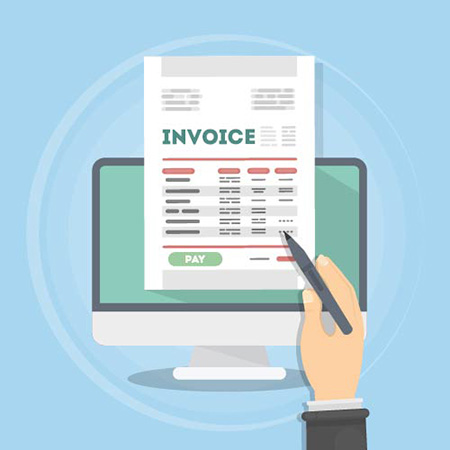How to mitigate the impact of inflation on your business
Inflation is a major factor that entrepreneurs and small business owners must take into consideration when crafting their business plans and setting prices. With careful planning and adaptation, businesses of all sizes can weather the effects of rising prices and stay competitive in today’s economy. Inflation affects many areas of businesses, such as pricing strategies, supply chain costs and marketing. It is important to assess the effects of inflation on a regular basis in order to remain profitable and successful. With proper management and strategic decision-making, small business owners can successfully navigate through periods of rising prices. In this article, we take a look at how inflation affects businesses and what business owners and managers can do about it.

What is inflation and how does it impact businesses?
Inflation is an economic phenomenon that results in a general increase in prices over a period of time. It can have a significant impact on businesses as it affects the cost of production and the revenue generated. When inflation increases, businesses must pay more for materials, labour, and other costs associated with producing goods and services. This can lead to higher prices for consumers, reduced profit margins, and even layoffs if companies are unable to pass those additional costs onto their customers. Additionally, rising inflation levels may also cause people to reduce spending due to decreased purchasing power caused by higher prices. This can further reduce demand for products and services leading to further financial losses for businesses.
What are the different types of inflation?
Inflation is typically divided into three main categories:
- Demand-pull inflation
- Cost-push inflation, and;
- Built-in inflation.
Demand-pull inflation occurs when consumer demand for goods and services increases faster than the economy can produce them. This causes prices to rise as businesses try to keep up with consumer spending, leading to an overall increase in the general price level.
Cost-push inflation happens when the costs of production increase without a corresponding increase in consumer demand. Some examples include higher costs of labour, raw materials, or energy needed to produce goods and services. When these costs go up, businesses will often pass those added expenses onto customers by increasing their prices—which raises the general price level across the economy.
Built-in inflation is a type of inflation that tends to happen over time due to the natural expansion of an economy. This type of inflation is usually seen in developing countries, where economic growth has led to a surge in demand for goods and services, pushing up prices as the country’s ability to produce them struggles to keep up with demand.
Inflation can also be categorised based on its speed or rate at which it occurs. Hyperinflation is a type of rapid, out-of-control inflation that typically happens when too much money is printed without enough real resources or assets backing it. This leads to an increase in money supply, which causes prices for goods and services to skyrocket quickly. By contrast, mild or moderate inflation is a slower rate of inflation that does not cause dramatic fluctuations in the general price level.
Overall, different types of inflation can have a huge impact on an economy, so it’s important to understand each type and how they are related. By recognising the various causes of inflation, governments and businesses can be better prepared to respond appropriately and reduce its negative effects.
How can a business protect itself from the effects of inflation?
One way businesses can protect themselves from inflation is by budgeting for it in advance. By staying abreast of current financial trends, business owners can plan ahead for any increases in the cost of goods or services due to inflation. This requires an understanding of the current market conditions, so business owners should keep a close eye on economic indicators such as the Consumer Price Index (CPI).
Businesses can also adjust their pricing to account for inflation. This may mean increasing prices in order to remain profitable, or it could involve finding ways to cut costs without sacrificing quality or customer satisfaction. Business owners should also look into hedging techniques such as futures contracts, options trading, and other methods of protecting against currency fluctuations due to inflation.
Finally, businesses need to be aware that inflation can affect the value of their investments and should monitor their portfolios to ensure they are not exposed to excessive risks. By taking proactive steps to protect against inflation, businesses can remain financially secure despite economic uncertainty.
What are some strategies for reducing the impact of inflation on a business?
One strategy for reducing the impact of inflation on a business is to increase operational efficiency. This is an area TaxAgility can assist with. We can help businesses review their operating costs and identify areas where they can improve efficiency, reduce waste, and save money. Additionally, businesses should look for opportunities to diversify their operations or enter new markets that may be less sensitive to inflationary pressures.
Businesses should also consider hedging strategies when dealing with inflation. Hedging involves taking measures to limit losses due to price fluctuations in commodities or currency exchange rates by investing in derivatives or forward contracts. This allows businesses to protect themselves from spikes in prices due to inflation and ensure that their operations remain profitable even amid unpredictable economic conditions.
In addition, businesses should consider diversifying investments by investing in a variety of different asset classes such as stocks, bonds and commodities. Diversification helps protect businesses from the effects of market volatility and can help ensure the long-term financial stability of a business even amid periods of high inflation.
Finally, businesses should seek out financing sources that offer fixed rates of interest. This will allow them to protect their profits from the effects of inflation and reduce the overall cost of debt financing.
These are just a few strategies for reducing the impact of inflation on a business. Business owners and executives should work with their financial advisors to identify which tactics might be most beneficial for their particular operations. By taking proactive steps to manage inflation risk, businesses can protect themselves against unexpected changes in prices and ensure long-term profitability.
Tips to help beat inflation
Setting a budget is an essential tool for mitigating the impact of inflation on your business. When you have a clear idea of what your income, expenses and profits look like, you can more accurately anticipate and plan for rising costs associated with inflation.
Keeping an eye on market trends will help you stay ahead of the game when it comes to understanding how inflation affects prices in your industry. Knowing which products or services are increasing in cost, and by how much, can give you a better idea of where to focus your efforts and budgets within the scope of potential price increases due to inflation.
Investing in commodities such as gold, oil, and other precious metals can help protect your business from the effects of inflation. As prices rise due to inflation, these assets tend to increase in value, which can help cushion the blow of rising prices.
Streamlining and improving processes within your organisation can be a great way to reduce costs and become more competitive while dealing with inflationary pressures. Investing in automated tools or technologies that increase efficiency or output can lead to greater savings over time when materials or labour costs rise due to inflation.
Financial hedging strategies such as currency swaps, forward contracts and futures are powerful tools for mitigating the impact of inflation on businesses operating globally or across different currencies. By managing the exchange rate risk associated with currency fluctuations, businesses can better prepare themselves for increases in prices due to inflation.
Last but not least, increasing your own prices is an effective way to combat the effects of inflation on your business. Understanding how much you need to raise your prices without driving away customers will take some careful consideration, but it’s often necessary when dealing with inflationary pressures.
How can businesses stay ahead of the curve when it comes to inflation?
In short, planning, foresight and common sense. By taking a proactive approach to inflationary pressures, businesses can ensure that they are well-prepared for any possible changes in the economy. They should be prepared for various scenarios and have contingency plans in place to address them. This includes developing the strategies mentioned above for hedging currency fluctuations or investing in different asset classes that can provide some protection from inflationary pressures. Businesses should also consider ways to reduce their operational costs, such as utilising energy efficiency measures or outsourcing services that would otherwise be costly in house. Taking these steps can help businesses stay afloat during periods of economic volatility caused by inflation and remain competitive in the long run.
How TaxAgility can help your business fight inflation
At TaxAgility, we don’t just provide an accounting service, we’re an extension of your financial team. We are here to help you identify the ways best suited to your unique business to fight the impact of inflation. We can help you do this by ensuring you maintain proper up to date management accounting information which allows you day-by-day to track income and expenses and the impact of rising costs on profit margins and cash flow.
We’re here to assist and advise as problems and opportunities arise. Call us today to discuss how we can help you keep a lid on the inflation’s impact on your business. Call today on: 020 8108 0090.
Note: This article is not intended to provide financial advice or guidance, it is for interest only.
Working from home and claiming tax relief on expenses
As more of us are now working from home, more often, because of the recent impact has had on businesses and attitudes concerning the practice of working from home, how can employees be reimbursed for the extra expenses they incur working from home, and what exactly can they claim for?
It comes as no surprise to find that many of us have had to work from home over the past couple of years. While in most cases this was forced upon us, it has had a significant effect on the attitudes of employers towards this practice.
Many employees have found it beneficial, as indeed have some employers, and want to continue, at least for part of the working week. Working from home imposes a range of costs on both employer and employee that prior to the recent pandemic, haven’t drawn that much attention. So when employees spend a considerable part of their work time working from their own home, how much of the extra expense can they claim, and what exactly is claimable?
What types of working from home expenses are we talking about?
Enabling an employee to work effectively from home requires more than a little thought and planning, there are real costs and expenses to consider. These may include:
- The cost of a laptop or other computer
- An internet connection
- A printer
- Printer and general office consumables
- A home office space and furniture
- Heating
- Lighting
- Telephone / mobile phone
Most people typically discover that while working from home can be a great convenience, their household bills start to increase, especially if normally both adults are at work, working the typical 9 to 5 office shift.
Then there are other considerations that are often forgotten, issues such as insurance come to the fore, personal and for additional equipment. Also, can an employee now claim expenses for a trip to the employer’s office?
Reimbursement vs tax exemption
It is important to understand how expenses are treated for tax purposes.
Reimbursement
If, as an employee, your employer reimburses the expenses you incur as a part of your job, HMRC must be satisfied that:
- No matter who did the job, the expense would have been incurred.
- It was necessary to perform your job.
- It was incurred in the performance of your duties.
- It was incurred and paid back to you.
- The expense was wholly and exclusively for your work.
If HMRC isn’t satisfied, you’ll run the risk of expense payment being treated as additional income and be taxed accordingly.
Tax exemption
If your employer doesn’t reimburse you for expenses incurred during the performance of your duties, you may be able to claim these against your income. That may be the case if for example your employer doesn’t reimburse you for the additional expenses of working from home. You must be able to prove, just like reimbursed expenses, that they were purchased wholly and exclusively for your job.
If this is the case then your expenses can be claimed against your income. For instance, if you earn £30,000 and you incur £5,000 of expenses, you will only pay income tax on £25,000.
Some common questions about claiming working from home expenses
Implications exist for both employers and employees where claiming expenses related to working from home are concerned. Let’s look at some of these.
Can employers reimburse homeworkers for their household expenses tax free?
The simple answer is ‘yes’ an employer can reimburse its employees when they work from home with your full agreement, provided they are ‘reasonable’ and provided that the employee working from home is a regular occurrence.
HMRC allows different levels of payment to be paid free of tax and national insurance without supporting evidence. For weekly paid employees, this is up to £6, and monthly paid employees can expect £26 a month.
Can an employee be reimbursed tax free for working expenses greater than these figures? Again, yes. However, you must be able to prove that the payments are wholly in relation to ‘reasonable additional household expenses’ and that you have supporting evidence to this effect.
When employees are given equipment for home use, is there an income tax charge?
Income tax charges for this type of expense usually arise because the equipment concerned is also being used for personal use. As such it’s considered a benefit and tax arises as a result. So, if the equipment is supplied and owned by the company and supplied for business use, not personal use, then a tax charge will not arise. The other condition is that this ‘benefit exemption’ is offered to all employees with similar employment terms. The equipment must also be returned when the home working ends or when an employee leaves, if not a chargeable benefit will arise.
[Learn more about how benefits in kind are treated by HMRC here]
If an employee purchases their own home-working equipment, can we reimburse them tax free?
As a consequence of Covid-19, there was a government scheme in place up to April 5th 2022 that allowed employees to be reimbursed tax free for home-office equipment purchases, provided the same benefit was available to other employees in a similar role. This has not been extended beyond April 6th 2022.
Can homeworkers claim tax relief on household expenses?
Yes, because not every employer will cover the cost of an employee working from home. However, there are limits. Firstly, just like an employer reimbursing employees for home use, it has to be fully justified as an expense incurred wholly, exclusively and necessarily in the performance of their duties. Usually this is difficult to achieve as the employee should not have had a choice to work from home - i.e. it was forced upon them by the employer. If they did have a choice in the matter, then this would not be allowed.
However, because of Covid-19, an employee can now claim the same weekly £6 or monthly £26 allowance through their Government Portal for tax years 2020/21 and 2021/22. This claim is possible even if the employee was asked to work from home on a single day in either tax year. For a person on the basic tax rate of 20%, they are able to claim £6 per week which equates to £1.20 per week, or £62.40 per year. 40% taxpayers can claim double this.
Again, it is possible to claim more, but as ever, complete records demonstrating the authenticity of the claim must be kept and be justifiable.
If an employee works from home can they claim tax relief on travel expenses for trips to the office?
This is a difficult and complex area. It requires the definition of what is an employee's permanent workplace and temporary workplace. It also depends on whether the employee is permanent or part-time.
HMRC considers a permanent place of employment that location where an employee attends in performance of their duties. Regular relates to the frequency of attendance or pattern of attendance. This means that going to the office everyday is a requirement, a visit once a week, fortnightly or monthly, may apply.
On the other hand, HMRC considers a temporary workplace a location an employee attends while fulfilling a temporary role or one of limited duration. If an employee spends more than 40% of their time at one location over a 24 month period, HMRC will consider this as a permanent workplace.
So, if an employee ordinarily works from home full-time and is required to travel to the office, the employee can claim unreimbursed expenses tax free - provided the travel is not made regularly, else it may be considered that the office is the permanent place of employment.
Accordingly, if an employee shares their time between two locations, such as a home-office and their real office, HMRC will consider this as ordinary commuting between two ‘permanent’ places of work.
Can you backdate working from home allowance?
Yes, HMRC will accept backdated claims for up to 4 years.
Am I eligible for working from home tax relief?
Yes, provided you had no choice in the matter and your employer asked you to. Then you can claim £6 per week / £26 per month (monthly workers).
Note that you cannot claim this allowance if your employer reimbursed your expenses for doing so or paid you an allowance.
How do you claim payment for working from home?
You can make a claim if you have a government portal account or through your regular SA100 tax return.
Record keeping
Making expense claims is one thing, making sure you have the evidence to support them is quite another. Most employees are used to claiming ad-hoc expenses from their employer, such as when they attend an off-site client meeting, attend a trade show, stay overnight somewhere or claim subsistence expenses. When it comes to claiming expenses that relate to the use of your home, HMRC quite naturally regards these claims with little more skepticism.
It’s essential that you keep accurate documents in relation to what you are claiming. If you are claiming for heating that you might ordinarily expect not to have to pay because ordinarily you work in an office from 9 to 5, then make sure you apportion a reasonable amount of the bill. Don't, for instance, claim for heating your entire house when in reality you’re using just one room.
When you’re unsure, talk to a tax expert like TaxAgility
Personal tax addition can be a complicated area and making claims for expenses if not properly validated and justified, can lead to serious consequences with HMRC. If you have any doubts or would like a tax expert to help you in making claims for tax relief, call TaxAgility today on: 020 8108 0090 and speak to one of our personal tax experts.
Employee benefits in kind, the P11D and what employers must report.
Attracting and retaining valued employees is not at all easy these days. One way employers like to try and ‘sweeten’ their employment packages is through benefits such as, private healthcare schemes, company vehicles to the humble mobile phone, but these have tax consequences too.
Why have benefits-in-kind (BIK) become such an issue?
You might wonder why in a time where employees find it increasing difficult to retain valued staff, why the Government is slowly making it unattractive to provide these benefits? The simple reason is that some companies have chosen to use this route to reduce their own tax bills by offering more benefits while providing lower salaries. Lower salaries mean less National Insurance and Pension costs. For instance on an employee earning £30K per year, the company pays 13.8% or in this case around £2,800 and then another £716 in pension payments per year. With a lot of employees, this soon mounts up.
It works the other way too. In years past, an employee may have been able to opt for benefits ion return for a reduced salary - called "optional remuneration arrangements”. By doing this, the employee would pay less tax and national insurance.
Company cars have received harsh treatment in recent years, with the tax rate currently at 37%. The only exception, one that is becoming increasingly interesting for employees, is having a fully electric vehicle. Current tax legislation applies a zero tax rate to this type of vehicle.
So, to make benefits-in-kind a less attractive way to reduce a company’s tax burden, the government has continued to tax them.
What employers need to know about benefits-in kind and the P11D.
As an employer you’ll need to understand what constitutes a benefit-in-kind, what to report, how to report it and what the deadlines for reporting are. So here’s a recap.
What is a benefit-in-kind (BiK)?
In short, a benefit-in-kind is any benefit (perk) that an employee or director receives which is not included in their salary or wages. If you’re not sure, talk to us.
What are considered benefits?
The list of actual ‘perks’ HMRC considers as benefits is quite extensive, covering around 60 categories. You can see the full benefits list here.
For most people it comprises typical things such as private medical insurance, a company car, child care, expense allowances, clothing, mobile phones, home use, fuel for personal cars, etc.
Mistakes are often made and employers / employees which can land them in trouble, such as when a director has overdrawn the director’s loan account by over £10,000. As this is deemed a loan, interest is due. Also, it’s very easy to forget about work related calls made from personal devices, such as a home phone or mobile and where this has been claimed back by the employee.
If you are not sure about any potential benefit you are giving or receiving, check with a knowledgable accountant like TaxAgility first.
How to Report Employee Expenses and Benefits
Employee expenses and benefits need to be submitted at the end of each tax year using form P9D or P11D, depending on the expense or benefit in question. The Government has provided a detailed list of common expenses and benefits online, clicking through to each of which will tell you which form you need, and how you should calculate what you owe.
You’ll need to submit a separate form for each employee; so if, for example, two full-time employees are provided with a mobile phone each for work, you’ll need to complete a separate P11D for each employee. If you submit a P11D you’ll also be required to submit a P11D(b), reporting what Class 1A National Insurance is due on your expenses and benefits payments. You can complete an online declaration if you didn’t submit a P11D, to ensure HMRC won’t contact you about it.
All forms should be filed through either HMRC’s PAYE Online service, your own payroll software, or by downloading the form online and posting it to the address you send your paper tax return to.
If you under-report on your employee expenses and benefits and, therefore, pay less tax than is required of you, you’ll likely be charged a penalty by HMRC if they believe your under-reporting to have been deliberate or due to carelessness. You may be asked to show evidence of how you accounted for each expense or benefit; records must be kept for three years.
PAYE Settlement Agreements
What are PAYE Settlement Agreements? It’s common for some employees to have to claim for small and infrequent expenses or benefits - perhaps a bond or reward for service or performance in a year, or a business trip claimed by the employee. These can be a pain to have to report separately. So, if you only pay small, irregular, and impracticable expenses or benefits to your employees you can simplify your tax and National Insurance Contributions by applying to receive a PSA so you only have to make one annual payment to cover all and any payments owed. Checkout our other article on PAYE Settlement Agreements (PAYE Settlement Agreement)
Are there any exemptions to benefits-in-kind?
The recent pandemic may have people asking this question, especially if they are using company cars. If your vehicle was not used for 30 days or more, you may be able to apply for an exemption. However, as with many things related to HMRC, you may need to be prepared to prove this.
As an employer, you generally don’t have to report typical expenses such as the following, provided that you are either paying a flat rate to your employee as part of their earnings - this must be either a benchmark rate or a special (‘bespoke’) rate approved by HMRC, or paying back the employee’s actual costs.
- business travel
- phone bills
- business entertainment expenses
- uniform and tools for work
Calculating Employee Earnings
Each employee expense or benefit will need to be calculated at a rate. The Government recommends you do this by adding the value of all expenses and benefits an employee has received over a given tax year to that of their annual salary (if they haven’t worked a full year with you, calculate the full-year equivalent of their salary and all expenses and benefits received).
When to report to HMRC using your P11D?
The deadline for submitting your P11D and P11D(b) is the 6th July after the end of the tax year. For the 2020/2021 tax year, for instance, the deadline is 6th July 2021. You must ensure that copies of the individual P11d forms are given to each of your employees by this deadline.
Class 1A National Insurance payments must be submitted by is July 19th or the July22nd if you are paying online.
Experienced P11D Tax Accountants
To speak with a professional to discuss whether you need to start paying tax on your employee’s expenses and benefits, contact us today on 020 8780 2349 or get in touch with us via our contact page to arrange a complimentary, no-obligation consultation.
How to get a PAYE Settlement Agreement (PSA)
 If you’re a small to medium-sized (SME) business owner with a number of employees, you may wish to consider applying for a PAYE Settlement Agreement (PSA) to simplify your tax and National Insurance Contributions (NICs) paid on small, irregular, and impracticable expenses or benefits paid out to your employees.Read more
If you’re a small to medium-sized (SME) business owner with a number of employees, you may wish to consider applying for a PAYE Settlement Agreement (PSA) to simplify your tax and National Insurance Contributions (NICs) paid on small, irregular, and impracticable expenses or benefits paid out to your employees.Read more
How to control costs

Cost control is different from cost cutting. Learn this financial discipline to keep a lid on your costs and improve profitability.
Not to be confused with cost cutting, cost control is all about financial discipline and it involves planning, managing and preserving your financial resources. It's good practice to follow in both good times and bad – and if you control costs consistently well over time, your business should benefit from a stronger operating position and better cash flow leading to a rise in the company’s current assets (such as more cash in the bank), which will undoubtedly strengthen the value of your company and its financial position.
In this article, our Accountants for small businesses in London aim to discuss all you need to know about cost control, including:
- The difference between cost control and cost cutting
- Cost control applications
- Who should be involved in the exercise
- Top tips to control costs
- Quick wins
- Habits to help you succeed
The difference between cost control and cost cutting
The main difference between cost control and cost cutting is that cost control is about the management of costs while cost cutting focuses on lowering costs.
Cost control is also about discipline and stewardship exercised throughout the business journey, during both good and bad times. Cost cutting, on the other hand, tends to kick in when the business is going through a rough patch and you want to save as much as possible.
Cost control is applicable to direct and overhead
Broadly speaking, costs can be categorised into direct and indirect. Direct costs are costs attributed to the production of specific goods or services.
Indirect costs or overhead costs, on the other hand, are ongoing expenses associated with running a business.
Here is a quick example – assuming you are a small publisher producing atlases to colleges. Your direct costs are cartographers, designers, printing, storage and the delivery charges from the warehouse to your clients. Your indirect costs are office rent, an e-commerce site to take orders, phone lines and emails to communicate with your clients, staff to support and market the products, among others.
Cost control can be applied to both direct and overhead costs. For example, you may engage freelance cartographers when possible and negotiate with your printer for a better deal to manage your direct costs. When it comes to controlling overhead expenses, you can choose to modernise your e-Commerce site and marketing efforts, implementing referral programmes that only cost you when a sale is realised.
Who should be involved in cost control?
Contrary to cost cutting which is usually a top-down approach, cost control involves your team members liberally, particularly your managers. Your employees are more likely to cooperate if they can understand how cost control can benefit the company and also themselves.
Here is an example – a client has three bank accounts in three different currencies and in the past, their in-house bookkeeper spent almost £1k a year on bank transfer fees because no one was ‘thinking about such small costs’. When the company director decided to make financial discipline as part of the corporate culture, ideas started to flow. The bookkeeper switched to using an online money transfer service when paying overseas suppliers and the company immediately reduced its bank fees significantly.
It is also possible to involve your suppliers as part of the cost control exercise. Once your suppliers know that you are taking a proactive step to control costs, they are likely to share with you options that can help lower your bills.
As cost control starts with a careful review of financial data, naturally you want to involve your accountant too. Talk to one of our small business accountants in London if you are looking for someone who can help you identify under-performing cost centres and suggest ways to reign in control.
Top four tips you can take to control costs
1. Reviewing the variances between actual costs and budgets
The main purpose of budgeting is to reduce careless spending and improve profits.
Every month our small business Accountants share a vital set of financial data called the management accounts with our clients. Among them is a document called budget variance which tracks how much you have budgeted to earn and spend in a particular month versus how much you have actually earned and spent during that period. Ideally, you want the actual figures to be as close to the budgeted figures as possible, as they indicate good planning, good execution, and less careless spending.
It is worth pointing out your budgeted figures must be realistic, based on historical data and market trends. For example, you shouldn’t expect to sell £10k worth of Christmas decorations to consumers in March (unless the figure is after some massive discounts). Equally, you can’t have a budget of £1k a month for marketing but choose to splurge on TV commercials.
2. Enhancing internal processes
Many businesses have their own set of procedures created years ago and some of these are so set in their ways to the point that no one questions if they are still relevant. Review every part of your internal processes and make the necessary changes to increase efficiency.
For example, your staff may still spend time on endless meetings, often involving everyone in the team and each meeting has a designated note taker. In reality, many companies have started to streamline meetings with clearly defined expectations and use apps to take notes.
3. Focusing on quality
Quality control is an essential tool in manufacturing, not just in producing an excellent product, but also in refining the production process as it can lead to zero wastage. Even if you aren’t a manufacturer, you can still apply the same principle to every product and service you offer.
Once you start to focus on quality, you will see an increase in satisfied customers, which is likely to lead to more sales and referrals. Together, they will create a positive feedback loop that will yield more favourable results, such as higher quality that will enhance value and allow you to potentially differentiate and charge higher prices to more customers.
4. Be well prepared
No business is risk-free and yet surprisingly, many small business owners aren’t prepared for the associated risks, let alone having robust plans to manage an uncontrolled loss of something valuable.
Risks that can affect a small business may include economic risk, compliance risk, financial risk, operational risk, fraud risk, reputation risk, and competition risk.
For instance, business owners know that the economy can fluctuate between periods of strong growth and weakness. As a business owner, you must be able to analyse the changes and trends pertaining to your industry. Your business must innovate, evolve, and adapt to stay relevant. Also, it is wise to set up a rainy day fund to tide the company over during an economic downtown.
A few quick wins
Controlling costs should not be a burdensome exercise and here are some easy savings you can make immediately:
- Finding alternatives to lower bank transfer fees – plenty of online money transfer services now charge less for each transaction than your bank.
- Using cloud computing – subscription-based or pay-as-you-go software and data storage remove expensive infrastructure in-house. At TaxAgility, we work with Xero, cloud-based accounting software that streamlines many common accounting processes, saving you time and money.
- Eliminate unnecessary costs – unneeded insurance, unused telephone lines, subscriptions that your staff don’t use, hiring staff when outsourcing can do the work, these are some costs you can eliminate immediately.
- Negotiating with your suppliers – apart from asking for discounts and better payment terms from your current suppliers, find out if there are alternatives. Also, look for alternative suppliers where possible.
- Rejuvenating your marketing programmes – try new approaches such as rewarding your loyal customers when they refer other buyers to you.
- Maximising your staff’s skills – many modern offices look for staff who can step up and be responsible for a variety of tasks. For instance, a marketer today should be able to manage a CRM system, design a newsletter, write compelling product descriptions, know how to take good product pictures and publish them online, among other tasks. If your marketer can only do limited functions, consider training and encourage them to grow, or find somebody who can.
Good habits can help you reach your goals
Financial discipline is about being consistent in your approach when it comes to planning, managing and preserving your financial resources. It is definitely not a one-time exercise. To be successful in cost control, you must be able to plan, set realistic goals, review results and spend time to sharpen your financial knowledge regularly.
At TaxAgility, we know that not every small business owner has the time to plan and interpret financial data, this is why our small business accountants are ready to assist. Our biggest strengths are in number crunching and applying solid financial principles to help you create and maintain the economic value for your company. So give us a call on 020 8108 0090 when you are ready to instil some financial discipline into your business.
TaxAgility can help you to control costs
Cost control often starts with a careful review of your major cost centres – your direct costs, sales and marketing, finance and administration, IT support, legal costs, to name but a few – over a period of six to 12 months. After that, you proceed to rank each cost and identify areas where savings can be made.
Your accountant is vital to your cost-control effort. At TaxAgility, our small business accountants have the experience to help you review your financial data and suggest ways which you can take to manage your costs and improve profitability.
We have three offices – in Putney, Richmond, and also at Cavendish Square in Central London – conveniently located to assist company directors and owners across London with a complete range of financial and business services, including Accounts & bookkeeping; Payroll management; Management consultancy; Personal tax planning and many more.
Call us today on 020 8108 0090. Alternatively, use our online form to arrange a complimentary, no-obligation meeting.
You may be interested in:
- Small business: managing rising costs
- Managing your business finance for success
- Actions you can take when your small business is in distress
This blog is a general summary. It should not replace professional advice tailored to your specific circumstance.
Tax guide for Christmas gifts

Non-cash Christmas gifts cost less than £50 an item can be considered as ‘trivial benefits’.
As the calendar year comes to an end and Christmas approaches, many small business owners in the festive spirit enjoy giving a token of appreciation to the team members. But before you go and splash out, here are the tax rules you need to be aware of.
- Cash or vouchers which can be converted to cash are not considered as trivial benefits. They are subject to tax and National Insurance.
- Christmas gifts that are less than £50 per head (inclusive of VAT), not considered as a reward for their work or performance, and not stated in the terms of their contract, can be considered as trivial benefits. In this case, they are exempted from tax and National Insurance.
Christmas gift examples
Some thoughtful Christmas gifts that are below the £50 mark and can be considered as trivial benefits include:
- Something traditional: a bottle of wine or a box of chocolate
- Something more personalised: a scarf, a pair of gloves or a personalised mug
- Something popular like small electrical items, anything from portable power banks for phones to adapters.
What about Christmas bonuses?
HMRC is clear on Christmas bonuses – any cash you give to employees as a Christmas bonus means earnings. This means you have to add the value of the bonus to your employee’s other earnings, pay PAYE tax and also National Insurance through payroll.
What about gifts from a third-party?
It is possible for your employees to receive gifts from a third party. For example, you run a bakery and your employees may receive a gift from a flour manufacturer. The gift can be cash, vouchers, cheques or items. What you have to report to HMRC depends on what kind of third-party reward your employee receives and whether you are involved in arranging the reward.
The rule of thumb is that if the cash or vouchers are involved, the third-party must deduct PAYE from the reward and you must deduct National Insurance on the combined value of the reward and the PAYE tax paid on it by the third party.
For non-cash goods, the third-party must account for the tax due on the reward and pay tax and National Insurance. However, if you are involved in arranging the reward, the third party will pay for the tax due and you are responsible for the National Insurance.
As this can get complicated quickly, the best approach is to talk to your tax accountant.
TaxAgility can handle your taxes
At TaxAgility, our small business accountants can provide tax advice concerning Christmas gifts and trivial benefits to all small business owners in London, Richmond and Putney. You can count on us to provide honest tax advice pertaining to:
- Corporate tax
- VAT
- Employers’ PAYE
- National Insurance
- Business rates
- Income tax (for directors and shareholders)
Give us a call today on 020 8108 0090 or get in touch with us via our contact page to arrange a free, no obligation meeting.
If you enjoyed this article, you might also be interested in:
- Tax rules for staff parties and annual events
- Accounting tips for small business
- Small business: managing rising costs
This post is intended to provide information of general interest about current business issues. It should not replace professional advice tailored to your specific circumstances.
Tax rules for staff parties and annual events

Beware of the £150 per head exemption before organising your office party.
The idea to get your team members away from work and their daily routines for a social function is sound and meaningful. Rightly so, HMRC recognises the importance of such social event and allows tax exemption to small business owners who look to reward their employees with a staff party or a social event.
Important tax rules on staff parties and annual events
HMRC is stringent when it comes to the extra perks you provide to your staff and the perks are subject to PAYE tax and National Insurance.
But once a year, HMRC allows you to spend £150 per employee which is an exemption, meaning you can claim them as a business expense. To qualify, the event must:
- Occur annually. It can be a Christmas party or a summer event.
- Cost less than £150 per employee. This cost includes VAT and other related expenses such as the event itself and transport.
- Available to all employees.
- Available to their partners, meaning their partners are also subject to the £150 per head limit.
- Applicable to shareholders who are also directors or employees.
What happens if my event costs average more than £150 per person?
If your annual event exceeds the £150 tax exemption per person, you cannot claim the first £150. Instead, you must report the whole amount to HMRC and pay National Insurance on the full cost of the event accordingly. In this instance, it is best to get help from your accountant as you will also need to complete form P11D for each employee.
Can I host more than one annual event?
Yes. Employers can host multiple annual events but must ensure that the combined cost of the events is no more than £150 per employee for the year. However, to make it easier, most business owners choose to use their tax exemption budget during a single occasion.
Let TaxAgility manage your taxes
Tax is probably not the favourite subject among many small business owners. In the UK, tax is a complicated subject and how much tax your business has to pay depends on its structure, the VAT option it chooses, and how much money it makes. We understand that not all small business owners can keep abreast of the latest tax changes, which is why our accountants for small business owners are here to assist.
When it comes to taxes, you can count on us to provide services pertaining to:
- Corporate tax
- VAT
- Employers’ PAYE
- National Insurance
- Business rates
- Income tax (for directors and shareholders)
Whatever you need, we are committed to making your business a success - contact us today on 020 8108 0090 or get in touch with us via our contact page to arrange a free, no obligation meeting.
If you enjoyed this article, you may also be interested in:
- Accounting tips for small business
- Small business: managing rising costs
- Five ways to improve your company’s cash flow
This post is intended to provide information of general interest about current business issues. It should not replace professional advice tailored to your specific circumstances.
How contractors should invoice for expenses

Knowing how to invoice for expenses when you first start out as a contractor, regardless of your profession, is crucial to ensure that you keep up a professional appearance and can breeze through the first few months of your contracting career.
As a contractor, you are likely to incur a few expenses when providing your services to clients. For example, you may need to travel and visit premises in another town (an expense which you incur), or you may need to purchase a piece of equipment on behalf of your client (a disbursement which you will invoice). To help you navigate the expense and disbursement process, our accountants for contractors in London at TaxAgility share three common methods that you are likely to encounter when invoices your clients for your expenses.
Adding VAT
Regarded as the simplest invoicing method, adding VAT involves charging VAT on any expenses you have incurred while working or carrying out your services for your clients, such as hotel stays, public transport expenses and mileage. In this case, you add the VAT regardless of whether or not you were charged VAT on these items in the first place.
For example, you performed £2,000 worth of work for your client and you incurred £40.00 in petrol cost due to driving out to an in-person meeting with your client (a cost they had agreed to reimburse), you would invoice them £2,448 and the breakdown is as follows:
- £2,000 for the work
- £40 for petrol cost
- £408 (20% VAT on £2,040)
Splitting VAT
In the event that your clients do not like the above method as they are paying VAT on the petrol cost twice, then you will need to remove any VAT you paid on expenses you claim back from them, then applying VAT to your final, gross invoice.
Let’s say you performed £2,000 worth of work for your client, and you also paid £1,200 (with VAT) for a training course which your client suggested you attend and promised to reimburse you for. In other words, the training cost is actually £1,000 + VAT £200.
In this case, you will invoice your client £3,600 and the breakdown is as follows:
- £3000 (£2,000 for the work + £1,000 for the training cost)
- £600 (20% VAT on £3,000)
Disbursement
Disbursement payments occur when you purchase something on behalf of your client and pass that cost over to them in your invoice. In this instance, you do not charge VAT on the items and you cannot claim back any VAT.
As explained by HMRC, there are various rules surrounding disbursement including:
- You paid the supplier on your client’s behalf and acted as the agent of your client.
- Your client received, used or had the benefit of the goods or services you paid for on their behalf.
- It was your client’s responsibility to pay for the goods or services.
- You had permission from your client to make the payment for the said goods or services.
- Your client knew that you were not the supplier of the goods or services.
- You show the costs separately on your invoice.
- You pass on the exact amount of each cost to your customer when you invoice them.
- The goods and services you paid for are in addition to the cost of your own services.
Here is an example: you performed £2,000 worth of work for your client and you incur £40 in petrol costs which the client would pay. To do the job, your client also asked you to purchase a piece of electronic (a Geiger counter worth £200) which they would need in the project. You will invoice £2,648 and the breakdown is as follows:
- £2,040 (£2,000 for the work done + £40 petrol expenses)
- £408 (VAT on £2,040)
- £200 (Geiger counter disbursement)
How can TaxAgility help contractors?
At TaxAgility, we understand that contractors are constantly juggling different tasks at once, which is why we want to step in and help. With the assistance of our dedicated accounting and tax services for contractors, you can focus on building your business while we manage your financial and tax affairs.
Our contractor tax and accounts services include:
- Setting up a limited company to help you get started
- On-going accounts and bookkeeping management for contractors
- IR35 support for contractors
- Construction Industry Scheme (CIS) support
- Corporate tax advice
- Self-Assessment tax returns
- Personal investments
If you would like to arrange a one-to-one meeting to discuss any tax or invoicing queries you might have, we offer a no-obligation, free consultation. Contact us today on 020 8108 0090 or get in touch with us via our Contact Page.
If you found this useful, take a look at:
- Understanding dividends
- IT contractor tax: What do I have to pay?
- Business expenses you can claim as an IT contractor
This post is intended to provide information of general interest about current business issues. It should not replace professional advice tailored to your specific circumstances.
Why outsource your payroll administration

As a business owner, you know that managing payroll in-house can be a complicated affair. The payroll process is time-consuming as the tasks include statutory sick pay, statutory maternity/ paternity/ adoption/ shared parental pay, student loan, holiday pay, bonuses, pension and various National Insurance classes, among other issues like preparation of various forms (such as P11, P35, P45, P46, P60) pertaining to employment.
Spending your time dealing with payroll may not make sense for a small business owner because there are other areas that need your attention. Equally, hiring a dedicated person in-house to manage payroll for a small team seems excessive too. This is why it makes sense to outsource your payroll administration to a professional payroll company like TaxAgility.
Here are the five reasons why outsourcing your payroll administration is a smart move.
Focus on other aspects of your business
As an employer, you are obligated to record your employees’ salary in payroll software, even if they get less than £116 a week. The process involves:
- Calculating deductions (taxes and National Insurance) from their pay.
- Calculating the company’s National Insurance contribution if their earnings are above £157 a week.
- Producing payslips for every employee.
- Submitting their pay and deductions to HMRC in a Full Payment Submission (FPS).
- Recording the payments.
Dealing with payroll is a time-consuming task. Every hour you spend on payroll administration is an hour that could be better spent developing your business or growing your business network. By allowing us to manage your payroll, you can turn your focus back achieving your business goal.
Lower your risks
Payroll is an on-going process that requires constant attention as HMRC is quick to issue a penalty. For example, in addition to paying your employees, you need to pay HMRC for the National Insurance contributions by the 22nd day of every month, otherwise you may have to pay a penalty.
In the event that you have paid your employees but forgotten to send the FPS to HMRC, they may also fine you.
When HMRC introduces a new law, like companies must now provide and pay into a workplace pension scheme for their employees, you need to be in full compliance of the law. The minimum contributions are 5% (2% from employer and 3% from employee) until 5 April 2019, then 8% (3% from employer and 5% from employee) after that day. With us staying on top of this issue, we can help you manage it so you’re compliant with the new law.
Cost saving
Outsourcing your payroll service can be highly cost-effective when you factor in the time spent on creating tax documents and monthly (or yearly) payroll software maintenance cost. You also don’t have to spend time learning the payroll software and manage the upgrade yourself.
Simplified National Insurance contributions
Splitting up into various categories, National Insurance contributions are complex. Understanding the classes – Class 1, 1A, 1B, 2, 3, 3A and 4 – alone require you to a good amount of time reading them. Leave them to the professionals because this is what we do best.
Full year-end payroll services
Every April, you will need to review your payroll reports, give your employees a P60 and prepare your employee records for the next tax year, plus you will also need to let HMRC know that it is your final EPS report of the year. There are certain dates you need to keep in mind, such as:
- Before 5 April: send your final EPS to HMRC.
- After 6 April: update your payroll software and employee payroll records.
- By 31 May: give your employees a P60.
- By 6 July: report employees expenses and benefits to HMRC.
- Our payroll service will gladly help you to manage the year-end payroll process.
Outsource your payroll administration to the professionals
If you want to spend less time on tedious payroll administration and more time on other areas of your business, the best thing you can do is to outsource the work to us. At TaxAgility, our team will provide you with consistent payroll administration as well as one-off payroll exercises like providing your employees with bonuses, overtime payments and commission.
Contact us today on 020 8108 0090 to discuss outsourcing your business’ payroll administration to our experienced accounting team in London. Alternatively, you can get in touch with us via our contact page to arrange a complimentary, no obligation meeting.
If you found this article useful, why not take a look at:
- How to grow your business: outsourcing the work
- Does HMRC object to putting family members on the payroll?
What is the 24 Month Rule for Contractor Expenses?
 The 24 month rule for contractor expenses is a law that allows contractors to receive tax relief on travel expenses should you be required to travel from your home to a temporary working location for a period of 24 months (two years) or less.
The 24 month rule for contractor expenses is a law that allows contractors to receive tax relief on travel expenses should you be required to travel from your home to a temporary working location for a period of 24 months (two years) or less.
If you qualify for such relief it will be paid to you, tax free, directly by your employer. Under the law, travel expenses refer to all reasonable costs that are incurred as a direct result of you having to travel from your home (permanent residence) to your temporary working location.
The Rule Defined
The 24 month rule for contractor travel expenses only applies towards the first 24 months of you being asked to work from a temporary working location if the contract is expected to last for no more than 24 months.
If the contract signals a permanent move, or the move is to last for more than 24 months, no relief will be available for any period. If, however, halfway through a shorter contract your temporary location becomes permanent, or the contract is extended so the total time at your temporary location will exceed 24 months, relief is no longer available from that point on, but relief claimed up until that point may be kept.
Similarly, if you’re asked to work full-time from a temporary location for longer than 24 months, but several (or many) months into your contract at this location your time there is shortened to less than 24 months, you’ll be able to claim relief on the remaining months you have at your temporary location, but you won’t receive relief for the months up to that point, as at that time your contract was intended to be longer than the two year threshold.
What is a Temporary Working Location?
A temporary working location, for the purpose of the 24 month rule, is any location that you aren’t expected to be at (and ultimately aren’t at) for longer than two years.
You should note, however, that if your temporary working location is close enough to your permanent work location that it doesn’t prompt a dramatic change in the journey you take or the cost incurred to get there, with your journey from home remaining largely the same, you won’t be able to claim relief, regardless of how short your temporary working contract is.
Qualifying Exceptions
There are, of course, exceptions to the rule.
If you’re required to work one day a week from a temporary location for a period longer than 24 months you’ll still be able to claim relief for your weekly journeys to your temporary working location because you won’t be spending more than 40 percent of your working time in this temporary location (you’ll be spending just 20 percent, in this example).
If you’re in your job for less than two years, or you’re moved to a new permanent working location, you cannot claim relief as at every stage your working location is considered to be permanent.
How to Take Advantage of the 24 Month Rule for Contractor Expenses
Hiring an accountant to take care of (and organise) your contractor expenses is a necessary business investment if you wish to spend less time worrying about what you’re owed, and more time focusing on your work.
To speak with a professional accountant to discuss the the process of claiming for contractor expenses, or for any other questions, contact us today on 020 8780 2349 or get in touch with us via our contact page to arrange a complimentary, no-obligation meeting.






